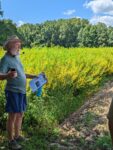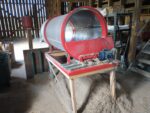Explore how SARE's farmer-driven research benefits American producers.
Showing 1-10 of 50 results

New Video: Plan for Stressful Times
Starting or taking over a family farming operation is an inherently stressful enterprise. And failing to plan for the impact stress can have on mental health poses real risk for any small business. At Flat Rock Dairy in Paulding, Ohio, dairy farmer Gretl Schlatter and Ohio State University Extension educator Sarah Noggle are working to […]

Farmer-Friendly SARE Grant Finds Poultry Production Efficiencies and Processing Barriers In Hawaii
Dependent on imports for more than 80% of their food, Hawaii’s people are perpetually at risk of supply chain interruptions due to natural disasters or other disruptions. Improving the capacity of local food production is one way farmers can generate income opportunities while reducing the remote islands’ risky reliance on imports. Nicole Correa of O‘ahu’s […]

Producer-Driven Research Finds Wood Chip Mulch Conserves Moisture and Improves Production Efficiency
In Virginia, using chipped wood for mulch can help manage weeds while increasing yield and cutting irrigation costs.

Adapting to Overgrazed Land and Drought on Joe Kipp’s Ranch in the Blackfeet Indian Reservation of Montana
On ancestral Blackfeet land in northern Montana, Joe and Kathy Kipp are breathing new life into overgrazed prairies.

Adapting to Extreme Rains and Drought at A-Frame Farm in Madison, Minnesota
At A-Frame Farm, resilience begins below the surface. In a new episode of America’s Heartland, produced in partnership with SARE, farmer Luke Peterson shares how his family is adapting to increasingly erratic weather through regenerative practices that focus on restoring the soil. Located on 500 acres in Madison, Minn., A-Frame Farm produces organic grains and […]

Adapting to Flooding and Drought on Hurricane Flats Farm in South Royalton, Vermont
On the banks of the White River, Hurricane Flats Farm is finding new ways to thrive in the face of increasingly unpredictable weather. In a new episode of America’s Heartland, produced in partnership with SARE, farmers Ashley Loehr and Antoine Guerlain share how they’re navigating both severe drought and catastrophic flooding on their 37-acre certified […]

Pennsylvania Producers Drive Research to Expand Switchgrass Markets
In Pennsylvania, switchgrass has emerged as a promising new crop for family farms. This perennial grass thrives on rocky, untillable land, requires minimal maintenance and reduces soil erosion. But a key challenge to expanding production has been the lack of stable markets and cost-effective methods of processing switchgrass for high-value applications like poultry bedding. In […]
Farmer-Led Innovation Improves Aquaculture Production and Ecosystems in New England
Southern New England’s climate offers ideal conditions for producing bay scallops—a sustainable seafood option that also diversifies aquaculture enterprises. However, an important challenge in bay scallop farming is access to nursery systems that can efficiently raise scallops to maturity before transferring them to grow-out environments. With support from a Northeast SARE Farmer grant, Dr. Daniel […]
Producer Partnerships Demonstrate the Benefits of Integrated Systems: Increased Profits and Soil Health
In the semiarid climate of the Great Plains, persistent drought is increasingly contributing to crop failure and soil erosion. A recent North Central SARE Research and Education grant in Kansas demonstrated how integrating crops, livestock and cover crops could help some producers offset revenue loss and failing crops. Kansas State University’s Dr. Augustine Obour partnered […]

The Value of Farming with Community
Shakera and Juan Raygoza talk about why their bonds with local consumers, families, schools, agricultural educators and other farmers are beneficial for both them and for the community where they live and farm. They operate Terra Preta Farm on 15 acres in Edinburg, Texas, where they grow organic radishes for wholesale markets and run a […]